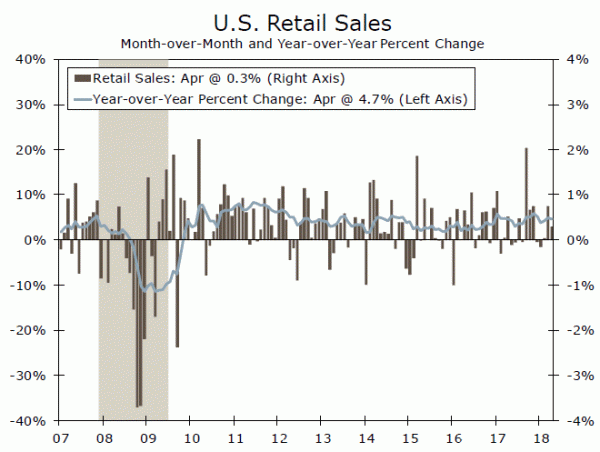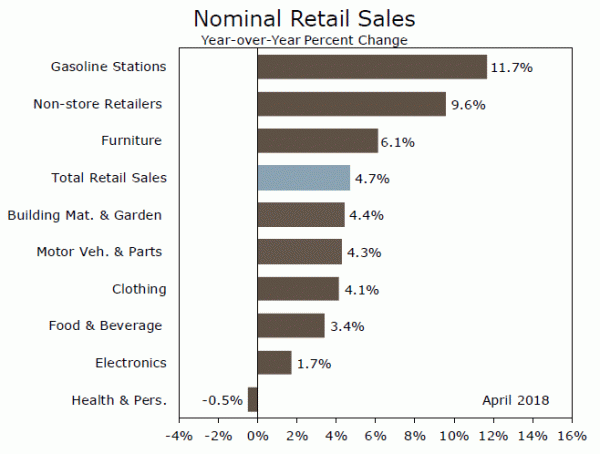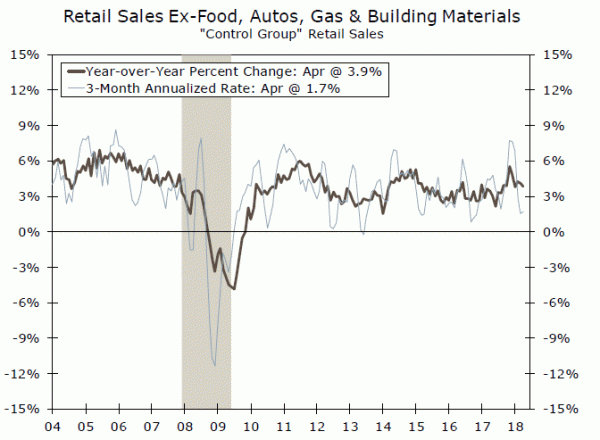Retail sales increased 0.3 percent in April while March sales were revised upward. The recovery in consumption seems to have started at the end of Q1, which bodes well for consumer demand in Q2.
Retail Sales Recover Strength in March and April
Retail sales were in line with market expectations in April, increasing 0.3 percent. However, March’s originally reported increase of 0.6 percent was revised upward to 0.8 percent. The details of the March revision were also strong, with retail sales excluding autos up 0.4 percent instead of 0.2 percent in March. For April, retail sales excluding auto sales were lower than expected, up 0.3 percent versus consensus’ 0.5 percent expectation. Retail sales excluding auto and gas were up a less-than-expected 0.3 percent, but just because March’s increase was revised up from a 0.3 percent increase to a 0.4 percent increase.
The strongest sectors of retail in April were clothing and clothing accessories stores’ sales, up 1.4 percent compared to a decline of 0.2 percent in March, while miscellaneous store retailers’ sales were up 0.9 percent. Meanwhile, gasoline stations’ sales were up 0.8 percent, mostly driven by the recent increase in gasoline prices. Non store retailers’ sales growth, on the other hand, moderated a bit from the strong, 0.9 percent increase in March to a still strong 0.6 percent rate in April. The next strongest sector in April was furniture & home furnishing stores’ sales, whose index increased 0.8 percent after an even stronger print in March, up 1.4 percent.
Meanwhile, building material & garden equipment & supplies dealers’ sales and food & beverage stores’ sales increased 0.4 percent in the month. Motor vehicle & parts dealers’ sales disappointed in April, increasing 0.1 percent but after a very strong month in March when it increased 2.1 percent. The weakest sectors in April were food services & drinking places’ sales, dropping 0.3 percent, health & personal care stores’ sales, down 0.4 percent, sporting goods, hobby, book & music stores’ sales, down 0.1 percent, and electronics & appliances stores’ sales, down 0.1 percent.
Relatively Strong End of Q1 and Start to Q2 for Control Group
Control group sales, which is the part of retail sales that is used to calculate GDP (bottom figure), was relatively strong in April, up 0.4 percent, while it was upwardly revised from 0.4 percent to 0.5 percent in March. Both results point to a recovery in economic activity at the end of Q1 and at the beginning of Q2. Still, there is some noise from the recent increase in oil and gasoline prices, which will probably bring down the real retail sales numbers.
Furthermore, the Department of Commerce indicated in the release that it will release a revision to monthly retail sales estimates on May 25, 2018. This estimate will include a new sample, new seasonal factors as well as the results of the 2016 Annual Retail Trade Survey. Thus, we will be looking closely at the seasonal factors as these could make a big difference in the revision to Q1 personal consumption expenditures (PCE) estimates. However, for now, the picture for the start of the second quarter is much better than the one we saw at the start of Q1, even with the old seasonal factors.














